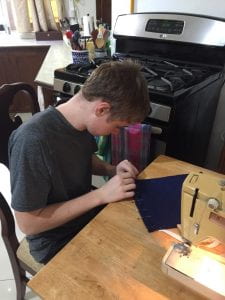In my last post, about my CAS/eagle project, I went over all of the planning phase for the project, with what my specific goal was and how I was going to get there. In this post, I’m going to show the physical work aspect of the project and the completion.
And so it began…
I didn’t actually start working on the bags immediately after the materials ordered for them had arrived. They had come on a Monday, and I wanted to get them all done in one massive batch, so I decided to wait until the weekend. On Friday, my mom helped me make a single bag of the pattern to see how it turned out, as well as how to most efficiently make them. I decided that the best course of action was to get through all the steps at a time, instead of making each one to completion and then starting the process again. This was because certain steps, like cutting the fabric into the correct shape and size, were done far more efficiently en masse. Doing each step all at once also increased the quality of the bags, as I would become very good at completing each step as it continued. Having decided on the order of events, we began at around 8 in the morning on Saturday. The goal was to produce about 35 bags by the end of the day, and fill them the next day. This was certainly going to be a challenge for me, as I didn’t really have much experience using a sewing machine or just making things out of fabric in general before this project, so I would have to learn a lot fast.
Speaking of steps, there were 6 distinct steps for making a bag
- Cutting the fabric pieces
- Making the initial stitches
- Making the secondary stitches
- Folding and ironing a part of the fabric(so it would be easier to sew)
- Sewing the “V” part of the fabric(for the drawstring to pass through)
- Cutting the ribbons for the drawstring and pulling them through
Let me just say, I’m very glad I set aside an entire day to make them because wow, it was time consuming. While I originally intended to go through each step on that list 35 times in a row before moving onto the next one, I ended up doing about 3 batches mainly because of how tired I was getting just doing the same thing over and over again. I’d say that each step was equally as time consuming, but I just kept going.


(measuring and cutting the fabric for the bags)
To my surprise however, there were relatively few issues along the way, and they all pertained to the sewing machine I was using. I didn’t think much of them, but it ended up as a major issue later in the day. Tragically, our family’s 50+ year old sewing machine properly broke down on us while I was using it at around bag 25. Luckily, I was able to borrow a sewing machine from some embassy friends but the process of finishing all the bags ended up getting delayed to the following weekend. I’m glad the only real problem I had was that easily solved.

(making the initial stitches)

(Now doing some of the more complex bits on the new machine)
In my last post, I had mentioned that I had placed a donation bin for travel sized toiletries at the embassy community liaison office(CLO). While I had expected that some people would probably donate items, I had no idea that I would get the huge response that I did. While I didn’t count the total amounts of everything people donated, we had more than 35 of every item to fill the bags with. It was really great to have the community support me like this, as without them a project like this wouldn’t have been possible.
With the items needed collected, the filling of the bags began.

(Sorting the items out before putting them into the bags)

(bags lined up and ready to fill)
Around this time, the blankets and pillows arrived from my Great Aunt, and so all the pieces of the project were together. The final step was simply putting them in the boxes and bringing it over to the embassy, which I did on February 5, 2020, marking the completion of my project.

(showing the individual bags to Mr.Groeneveld, the embassy representative who I corresponded and collaborated with throughout the project)
Conclusion
The entire process of this CAS project and Eagle Scout project has been a fantastic experience. I was able to learn so much as well as give back to a community that has always been supportive. Not only have I improved my hands on real world skills like sewing, I’ve mainly improved and learned how to collaborate in a professional manner and plan out a large project and execute said plan effectively. My actual product is quite interesting, in the sense that I hope that there is never a situation that requires it to be used, and I hope that all it has to do is sit on a shelf in the Embassy. I’m very grateful for an opportunity to apply ideas and things I’ve learned from boy scouts into this project, and I think it allowed me to make a lasting positive impact.